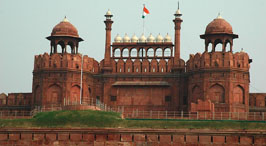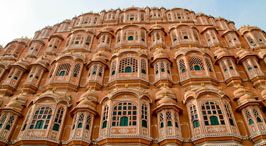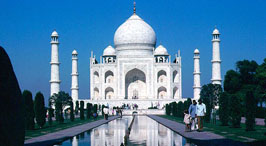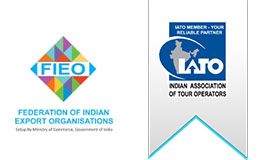TRAVEL INFORMATION INDIA
Golden Triangle with Maharaja Express
Golden Triangle tour is an integral part of any trip to India, as it entails visiting three Indian cities of Delhi, Jaipur and Agra, which essentially capture the essence of India’s vibrant culture and rich heritage. These three most visited Indian cities by tourists from around the globe, form a triangle, and are considered to be a must see for any one visiting India for the first time.
The fascinating Golden Triangle Trip takes you through Delhi, exploring its magnificent monuments and vibrant markets, to the stunning pink city of Jaipur, and to Agra, the historic mughal city of the iconic Taj Mahal. The three cities are distanced about 250 kilometers from each other and are seamlessly connected by road, rail and air.
The Golden Triangle Tour can be taken as a standalone package starting from 3 nights / 4 days, or can be covered with any other tour program. The following insights into the three destinations of Delhi, Agra and Jaipur provide you with all necessary information about the Golden Triangle Tour, and can be aptly referred to as a “Classic Introduction to India”.
DELHI

Delhi, the capital of India, is one of the most versatile cities of the country, where one can witness the coexistence of magnificent monuments of the Mughal Era, the imperial elegance of Lutyen’s New Delhi, and the cosmopolitan culture of the 21st century.
Divided into two parts, Old Delhi and New Delhi, this bustling metropolis enchants the visitor with magic of the bygone era, and thrills them with the visible aspirations of modern India.
Old Delhi is home to most of the historical sites, which are crowded by narrow lanes, well known for their hustle-bustle. The most stupendous monument is the Red Fort or the ‘Lal Qila’, standing as a reminder of the Mughal rule, but now symbolizing the sovereignty of the country. At walking distance from Red Fort, is Jama Masjid, the largest mosque in the country, with a sitting capacity of 25,000 devotees. This monument of architectural perfection of early India was built over a period of 13 years.
Chandani Chowk, the lively market of Old Delhi offering traditional Indian wear and jewelry, is a must visit place, as one enjoys a ride on a cycle rickshaw passing through its busy bye-lanes. A World Heritage site, the Humayun’s Tomb, is the first edifice of the Mughal architecture in the sub continent, built by the wife of Mughal emperor Humayun.
Another tourist attraction is the towering Qutub Minar, standing at a height of 72.5 meters. Made of red sandstone and carved with verses of the Holy Quran, this is yet another World Heritage site.
Visit to the city is incomplete without seeing the modern symbols of new India like India Gate, Rashtrapati Bhawan, Jantar Mantar, as well as paying tributes to Mahatama Gandhi, father of the nation at Raj Ghat.
Some modern religious places in Delhi include the Akshardham Temple, Birla Mandir, Lotus Temple, Gurdwara Bangla Sahab, and the ISKCON Temple.
A new landmark, Kingdom of Dreams, in the adjoining millinium city of Gurgaon, has become a rage amongst visitors.
One can wind up the Delhi sight-seeing by indulging in shopping as well as enjoying mouth watering Indian delicacies at Connaught Place, South Extension, Khan Market, Karol Bagh and Sarojini Nagar markets.
JAIPUR

Popularly known as the Pink City, Jaipur is the capital of the historic Indian state of Rajasthan. Equidistant from Delhi and Agra, Jaipur is one of the three destinations of the Golden Triangle Tour. Famous for its Grandiose Hill Forts and Majestic Palaces, the city has lots to offer to visitors – peak into the royal legacy, wealth of handicrafts and colorful pageants and festivals.
The most visible landmark of Jaipur is the towering Amber Fort, located atop a hillock, which is well known throughout the World for its Hindu and Rajput blend. The Palace complex within the fort consists of many monuments like Diwan-e-Aam, Diwan-e-Khas and the Sheesh Mahal. Other famous forts of Jaipur include the Jaigarh Fort and the Nahargarh Fort.
Hawa Mahal or the “Palace of the Breeze”, built in the year 1799, having 8953 little windows and balconies (called Jharokhas), provides a glimpse of stunning Rajput artistry. This five storey Palace was originally built by Maharaja Sawai Pratap, to enable ladies of the royal household to watch everyday life.
Located right in the heart of Jaipur, the City Palace was originally the seat of the Maharaja of Jaipur. This includes the Mubarak Mahal, Mukut Mahal, Maharani’s palace, Shri Govind Dev Temple and the Chandra Mahal. The City Palace has now been converted to a museum.
Other famous destinations of Jaipur include the Jantar Mantar, Jal Mahal, and the Birla Mandir. One can enjoy shopping for Rajasthani costumes, handicrafts, gem stones, silver jewelry and mementos from MI Road and other local markets.
In the evening, enjoy the short rickshaw ride.
AGRA

Located about 200 kms from Delhi, Agra, the capital city of the erstwhile Mughal kingdom, is a well known city on the world tourist map due to the stunning and spellbinding Taj Mahal, and other stunning architectural structures and gardens of the Mughal era.
Taj Mahal, the symbol of love and one of the Seven Wonders of the World, is a UNESCO World Heritage Site. Standing on the banks of river Yamuna, the Taj Mahal was built by Mughal Emperor Shah Jahan in the memory of his wife Mumtaz Mahal. Constructed with white marble in the year 1653, symbolized by its 16 gardens and 53 fountains, Taj Mahal was built in a period of 22 years with the contribution of over 20,000 workers, masons and jewelers.
Another World Heritage site, the Agra Fort, popularly known as the Red Fort, whose construction was started by Emperor Akbar and completed by his grandson Shah Jahan, is located near the Taj Mahal Gardens on the banks of River Yamuna. Built in red sand stone, the 2.5 kms long fort has many monuments within its periphery such as the Shah Jahani Mahal, Jahangiri Mahal, Khas Mahal, and audience halls Diwan-e-Am and Diwan-e-Khas, besides the Fish Pavilion, the Nagina Masjid, Garden of Grapes and the Pearl Mosque.
Fatehpur Sikri, a town situated 40 kms on the Jaipur road, is another marvel in red sand stone built by Emperor Akbar to celebrate the birth of his son Salim, as well as to honor the Saint Sheikh Salim Chishti. The architecture of the town is a mixture of Islamic and Hindu styles of constructions. A popular tourist attraction, this town is enriched with many historical monuments such as Buland Darwaza, Panch Mahal, Diwan-e-Am, Jama Masjid, Diwan-e-Khas and the Sheikh Salim Chisti tomb.
Maharaja Express guest always special for us



